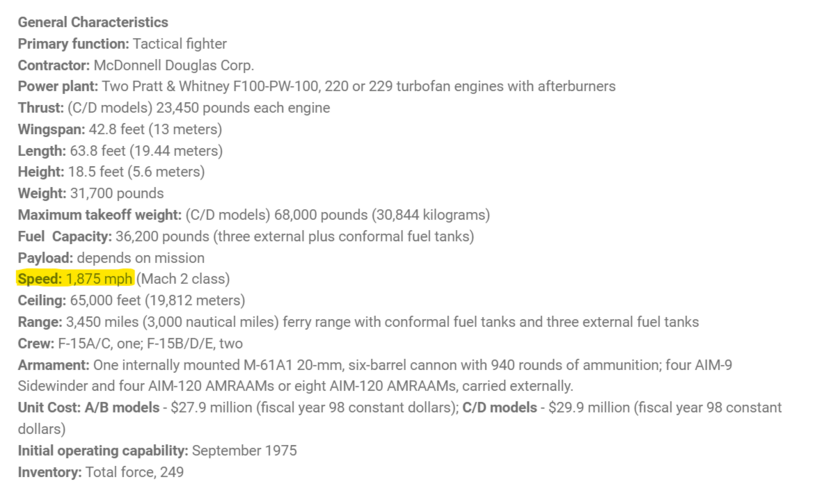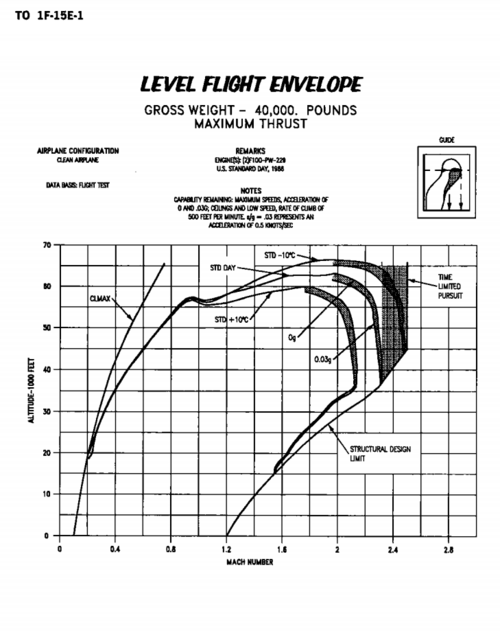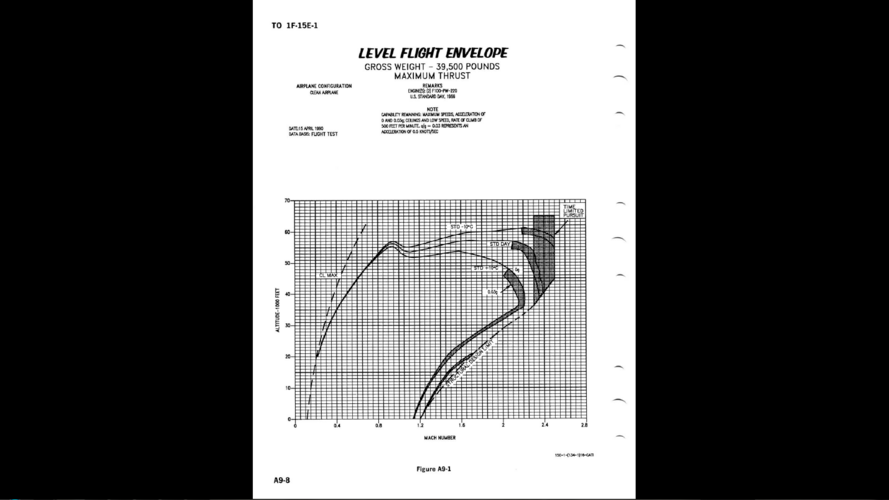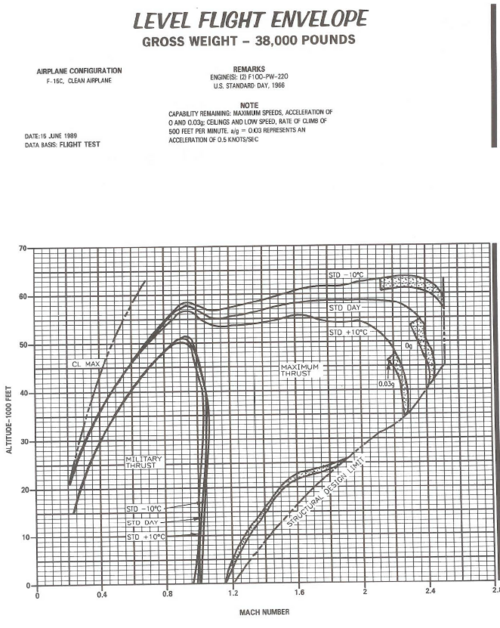You are using an out of date browser. It may not display this or other websites correctly.
You should upgrade or use an alternative browser.
You should upgrade or use an alternative browser.
aonestudio
I really should change my personal text
- Joined
- 11 March 2018
- Messages
- 2,881
- Reaction score
- 7,120

"I Would Love To Have More F-15EXs," Air Guard Boss Says
With F-15EX's operational debut coming soon, its unique capabilities have already made an impact on the Air National Guard's top officer.
A Boeing F-15EX can reach nearly Mach 3 in controlled flight in a “clean” configuration, meaning no external pylons, munitions or sensors, Boeing’s program manager said Feb. 21 at the Singapore Airshow.
“Yeah, it’s fast,” said Boeing’s Rob Novotny, a former U.S. Air Force F-15 test pilot.
Specifically, the not-to-exceed speed of the twin-engined fighter is about Mach 2.9, or about 2,225 mph at sea level, Novotny said. That puts the top speed of the Eagle II within about 80 mph of Mach 3, a speed only a few aircraft powered by gas turbines have achieved.
from AWIN

“Yeah, it’s fast,” said Boeing’s Rob Novotny, a former U.S. Air Force F-15 test pilot.
Specifically, the not-to-exceed speed of the twin-engined fighter is about Mach 2.9, or about 2,225 mph at sea level, Novotny said. That puts the top speed of the Eagle II within about 80 mph of Mach 3, a speed only a few aircraft powered by gas turbines have achieved.
from AWIN

Forest Green
ACCESS: Above Top Secret
- Joined
- 11 June 2019
- Messages
- 8,219
- Reaction score
- 13,901
Full article here:
Boeing Boasts Near Mach 3 Top Speed For F-15EX | Aviation Week Network
An F-15EX can reach nearly Mach 3 in controlled flight in a “clean” configuration, a Boeing program manager revealed at Singapore Airshow.
- Joined
- 4 July 2010
- Messages
- 2,423
- Reaction score
- 2,793
If they're at 2.9 that's a resounding "yes," especially if they didn't have to immediately replace the canopy after the flight.Did they procure a non-melty windcreen / canopy material? Or is this a theoretical value.
Thermal limit on the legacy models was M2.5 for 1 minute.
- Joined
- 3 June 2011
- Messages
- 17,929
- Reaction score
- 11,110
So much BS. No way in hell it's going Mach 2.9 at sea level.A Boeing F-15EX can reach nearly Mach 3 in controlled flight in a “clean” configuration, meaning no external pylons, munitions or sensors, Boeing’s program manager said Feb. 21 at the Singapore Airshow.
“Yeah, it’s fast,” said Boeing’s Rob Novotny, a former U.S. Air Force F-15 test pilot.
Specifically, the not-to-exceed speed of the twin-engined fighter is about Mach 2.9, or about 2,225 mph at sea level, Novotny said. That puts the top speed of the Eagle II within about 80 mph of Mach 3, a speed only a few aircraft powered by gas turbines have achieved.
from AWIN
View attachment 720536
martinbayer
ACCESS: Top Secret
- Joined
- 6 January 2009
- Messages
- 2,975
- Reaction score
- 3,122
Actually, I think it sounds hotter...Whatever you want to call the Armstrong limit. I admit the "blood boiling" is rarely something that literally happens and is a little dramatic, but it sounds cooler.
icyplanetnhc (Steve)
Trekking into the cosmic ocean
To be frank I'm rather unconvinced by these statements. Not withstanding thermal issues with the windscreen and the aluminum alloy that the F-15's structure is predominately constructed from, or inlet stability issues, or shock impingement on various structures, he's using a mph value of Mach 2.9 at sea level, which is clearly incorrect. Perhaps he misspoke and is being misquoted?Full article here:
Boeing Boasts Near Mach 3 Top Speed For F-15EX | Aviation Week Network
An F-15EX can reach nearly Mach 3 in controlled flight in a “clean” configuration, a Boeing program manager revealed at Singapore Airshow.aviationweek.com
- Joined
- 2 August 2006
- Messages
- 3,216
- Reaction score
- 1,354
They're not saying it's going that speed at sea level. That's just the dumb author saying that's what the velocity would be at sea-Level; i.e. - take the sea level speed of sound and multiply it by 2.9.So much BS. No way in hell it's going Mach 2.9 at sea level.
So much BS. No way in hell it's going Mach 2.9 at sea level.
In fairness, I don't think the altitude qualifier refers to the flight altitude, but that Mach 3 (in the stratosphere) means the aircraft is moving at 2225mph (TAS, i.e. equivalent to IAS at sea level).
EDIT: What Sundog said.
icyplanetnhc (Steve)
Trekking into the cosmic ocean
Another possible interpretation is that Mach 2.9 is the flutter limit. Usually for US designs, the flutter limit is 1.15 times the limit speed, so for a Mach 2.5 max speed, Mach 2.875, or roughly 2.9, would be the flutter limit. These limits are determined usually through analysis and calculations.
Last edited:
but that Mach 3 (in the stratospause) means the aircraft is moving at 2225mph (TAS, i.e. equivalent to IAS at sea level)
Fixed that for you.
Forest Green
ACCESS: Above Top Secret
- Joined
- 11 June 2019
- Messages
- 8,219
- Reaction score
- 13,901
Yeah, he basically calculated the speed from the Mach number using the speed of sound at sea level, which is silly since it would obviously have been at altitude. It's a very common mistake and continual iterations from Mach to kph/mph at sea level and back to Mach using speed of sound at altitude lead to certain hypersonic missiles creeping up from Mach 8 to Mach 10+.To be frank I'm rather unconvinced by these statements. Not withstanding thermal issues with the windscreen and the aluminum alloy that the F-15's structure is predominately constructed from, or inlet stability issues, or shock impingement on various structures, he's using a mph value of Mach 2.9 at sea level, which is clearly incorrect. Perhaps he misspoke and is being misquoted?
The figure he should have used for Mach 1 is 1,062kph or 660mph. 3 times that is 1980mph, 2.9 times is 1914mph. *Assuming it was between 11km and 20km altitude, which it likely was.
- Joined
- 3 June 2011
- Messages
- 17,929
- Reaction score
- 11,110
They're not saying it's going that speed at sea level. That's just the dumb author saying that's what the velocity would be at sea-Level; i.e. - take the sea level speed of sound and multiply it by 2.9.
Oh, they changed it.

- Joined
- 13 June 2007
- Messages
- 2,108
- Reaction score
- 2,760
I read all this as typical manufacturer hype - who's going fly a EX clean anyway unless they are tryng to break some speed record?
Enjoy the Day! Mark
Enjoy the Day! Mark
Kiltonge
Greetings Earthling
- Joined
- 24 January 2013
- Messages
- 561
- Reaction score
- 948
Fastest achieved speed I can find for the F-15A/C is Mach 2.544 at 47,200ft in August 1973. This was a performance envelope flight with newly revised, strengthened stator blades in the F100s. Previously the stators had limited it to Mach 2.3.
Info from AvWeek.
Info from AvWeek.
Last edited:
BlackBat242
OK, I changed my personal text ;)
- Joined
- 10 April 2013
- Messages
- 1,277
- Reaction score
- 3,516
And that was with F100-P-100 engines producing 14,670 lb thrust dry and 23,830 lb thrust in afterburner.Fastest achieved speed I can find for the F-15A/C is Mach 2.544 at 47,200ft in August 1973. This was a performance envelope flight with newly revised, strengthened stator blades in the F100s. Previously the stators had limited it to Mach 2.3.
Info from AvWeek.
The P&W engines in the F-15Es are the F100-P-229 (17,800 lb/29,100 lb) or -229A (17,800 lb/32,000 lb).
The engines in the F-15K/SG/SA/EXs are the F110-GE-129 (17,000 lb/29,500 lb).
icyplanetnhc (Steve)
Trekking into the cosmic ocean
The clean envelope charts for the F-15E indicate maximum speed of Mach 2.4 with the F100-PW-220, and Mach 2.3 with the F100-PW-229, both at standard day temperature. Perhaps some internal limit (TIT or compressor discharge temperature?) in the-229 is being reached sooner than on the -220? Mach 2.5 is possible for both at colder temperatures of 10 degrees C below standard day. The F-15C with -220 engines will reach Mach 2.45 on a standard day, being a lighter airframe than the F-15E.And that was with F100-P-100 engines producing 14,670 lb thrust dry and 23,830 lb thrust in afterburner.
The P&W engines in the F-15Es are the F100-P-229 (17,800 lb/29,100 lb) or -229A (17,800 lb/32,000 lb).
The engines in the F-15K/SG/SA/EXs are the F110-GE-129 (17,000 lb/29,500 lb).
Attachments
Last edited:
- Joined
- 15 January 2021
- Messages
- 341
- Reaction score
- 1,168
You are quoting sea level, standard day, uninstalled thrust numbers. While they are useful for comparing various engine performance potentials in the heart of the flight envelope, they often do not reflect the performance at the far right high speed limits of the envelope, where high inlet temperatures and pressures often cause the engine to reach internal limits that affect the performance of each engine differently, some more than others. Especially if the engine was not specifically designed for that part of the envelope. During some F-111 re-engining studies, it was determined that the TF30-P-111 (25,100 lbs in AB) had more thrust than the F110-GE-129 (29K in AB) at both 1.2M sea level and 2.5M / 50K.And that was with F100-P-100 engines producing 14,670 lb thrust dry and 23,830 lb thrust in afterburner.
The P&W engines in the F-15Es are the F100-P-229 (17,800 lb/29,100 lb) or -229A (17,800 lb/32,000 lb).
The engines in the F-15K/SG/SA/EXs are the F110-GE-129 (17,000 lb/29,500 lb).
And the F100-229A (AKA -232) never went into production for the F-15E).
Forest Green
ACCESS: Above Top Secret
- Joined
- 11 June 2019
- Messages
- 8,219
- Reaction score
- 13,901
A clean Tornado GR1 could fairly shift on the deck.The 111 went away too early. I wish it would still be based in Lakenheath and outrun Typhoon and Rafale on the deck every day for fun, a beer or a sandwich.
siegecrossbow
I really should change my personal text
- Joined
- 12 March 2012
- Messages
- 540
- Reaction score
- 1,405
If the F-15 can fly at M2.9 at high altitude in a clean condition I assume that it has a heat-resistant windscreen and cockpit canopy?
Not to take away from the achievement but the speed of sound is faster the denser the medium.
icyplanetnhc (Steve)
Trekking into the cosmic ocean
That's not quite correct. The equation for the speed of sound is c = sqrt(gamma * (R/M) * T), where gamma is the adiabatic index (ratio of specific heats), R is the molar gas constant, M is molar mass of the gas, and T is absolute temperature.Not to take away from the achievement but the speed of sound is faster the denser the medium.
This can be observed where the speed of sound decreases from sea level to the tropopause where it remains constant, and then increases again in the stratosphere as temperature increases. Density meanwhile is constantly decreasing with altitude.
Colonial-Marine
UAVs are now friend, drones are the real enemy.
- Joined
- 5 October 2009
- Messages
- 1,393
- Reaction score
- 1,170
I believe the conformal fuel tanks are only cleared to go up to around M2.4, remove those and you probably could get a F-15EX to M2.5 or whatever it was the Eagle managed in testing, but I'm guessing anything above M2.3 is still time-limited in the flight manual due to structural longevity reasons.
To reach that full speed in common temperatures the early F-15s needed to use a VMax switch which pushed the F100-PW-100 engines beyond 100% for a few minutes. I presume it worked with the F100-PW-220 as well. The PW-229 and (probably) the F110-GE-129 are running hotter by default so that switch doesn't do anything. I'm not even sure if later variants have that switch since only some early F-15Es had the PW-220 before they switched to the PW-229.
So either Boeing redesigned a bunch of things (including the CFTs) to withstand higher temperatures on the F-15EX or the sales guy is making stuff up. Maybe some of both?
To reach that full speed in common temperatures the early F-15s needed to use a VMax switch which pushed the F100-PW-100 engines beyond 100% for a few minutes. I presume it worked with the F100-PW-220 as well. The PW-229 and (probably) the F110-GE-129 are running hotter by default so that switch doesn't do anything. I'm not even sure if later variants have that switch since only some early F-15Es had the PW-220 before they switched to the PW-229.
So either Boeing redesigned a bunch of things (including the CFTs) to withstand higher temperatures on the F-15EX or the sales guy is making stuff up. Maybe some of both?
I believe the conformal fuel tanks are only cleared to go up to around M2.4, remove those and you probably could get a F-15EX to M2.5 or whatever it was the Eagle managed in testing, but I'm guessing anything above M2.3 is still time-limited in the flight manual due to structural longevity reasons.
The CFTs (both types) are limited to M2.0 or at least they used to be in the 1993 flight manual. Don't think that has changed since there really is no need to go faster with CFTs but otherwise clean aircraft.
I'm not even sure if later variants have that switch since only some early F-15Es had the PW-220 before they switched to the PW-229.
More than half of the USAF Strike Eagles have the -220 engines - 134 vs 102 with -229 engines.
So either Boeing redesigned a bunch of things (including the CFTs) to withstand higher temperatures on the F-15EX or the sales guy is making stuff up. Maybe some of both?
He said clean, so the CFTs wouldn't have to be redesigned either way.
But I'm pretty sure no F-15, EX or otherwise, ever came close to M2.9. Maybe they figured the F-15EX has enough thrust to reach that speed in theory.
dark sidius
ACCESS: Top Secret
- Joined
- 1 August 2008
- Messages
- 926
- Reaction score
- 702
This come by Boeing speaker , it could be possible near mach 3 , in clear configuration, they spoke about that 2 years ago when they spoke about the possibility to launch hypersonic missile with F-15 EXThe CFTs (both types) are limited to M2.0 or at least they used to be in the 1993 flight manual. Don't think that has changed since there really is no need to go faster with CFTs but otherwise clean aircraft.
More than half of the USAF Strike Eagles have the -220 engines - 134 vs 102 with -229 engines.
He said clean, so the CFTs wouldn't have to be redesigned either way.
But I'm pretty sure no F-15, EX or otherwise, ever came close to M2.9. Maybe they figured the F-15EX has enough thrust to reach that speed in theory.
icyplanetnhc (Steve)
Trekking into the cosmic ocean
Boeing Withdraws Near-Mach 3 Claim For F-15 | Aviation Week Network
A Boeing F-15 is still quite fast, but not nearly Mach 3, the company’s program manager said on Feb. 23, correcting a previous statement.
So the Boeing PM misspoke after all, it’s Mach 2.497, not Mach 2.9.
dark sidius
ACCESS: Top Secret
- Joined
- 1 August 2008
- Messages
- 926
- Reaction score
- 702
It is fast compare to the 1.6 of the F-35Boeing Withdraws Near-Mach 3 Claim For F-15 | Aviation Week Network
A Boeing F-15 is still quite fast, but not nearly Mach 3, the company’s program manager said on Feb. 23, correcting a previous statement.aviationweek.com
So the Boeing PM misspoke after all, it’s Mach 2.497, not Mach 2.9.
Doesn't the F-15 have an aluminum airframe? I always thought that heating limited aluminum airframes to Mach 2.5 at most. If so, we may have another measure of the quality of Boeing management.Boeing Withdraws Near-Mach 3 Claim For F-15 | Aviation Week Network
A Boeing F-15 is still quite fast, but not nearly Mach 3, the company’s program manager said on Feb. 23, correcting a previous statement.aviationweek.com
So the Boeing PM misspoke after all, it’s Mach 2.497, not Mach 2.9.
Scott Kenny
ACCESS: Above Top Secret
- Joined
- 15 May 2023
- Messages
- 9,159
- Reaction score
- 10,197
Like most Boeing products, it's a mix of aluminum and titanium parts.Doesn't the F-15 have an aluminum airframe? I always thought that heating limited aluminum airframes to Mach 2.5 at most. If so, we may have another measure of the quality of Boeing management.
dark sidius
ACCESS: Top Secret
- Joined
- 1 August 2008
- Messages
- 926
- Reaction score
- 702
Communication for the futur NGAD contract....Doesn't the F-15 have an aluminum airframe? I always thought that heating limited aluminum airframes to Mach 2.5 at most. If so, we may have another measure of the quality of Boeing management.
siegecrossbow
I really should change my personal text
- Joined
- 12 March 2012
- Messages
- 540
- Reaction score
- 1,405
Boeing management: it is Mach 3 because we round 2.5 upward.
- Joined
- 13 June 2007
- Messages
- 2,108
- Reaction score
- 2,760
New math has you round down to 2 for 2.497Boeing management: it is Mach 3 because we round 2.5 upward.
Last edited:
Similar threads
-
-
J
-
-
-
Poland Attack Helicopter competition between Bell and Boeing
- Started by RavenOne
- Replies: 19




